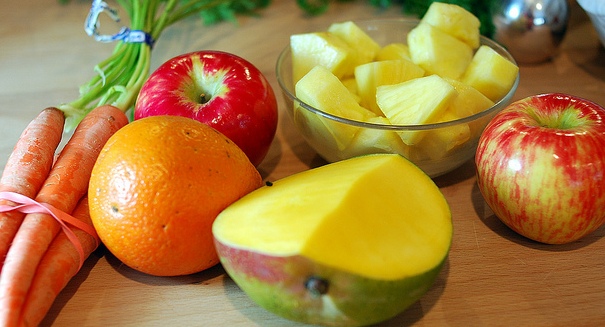
Eat more blueberries, grapes and apples.
Adding more whole fruits to your diet, especially blueberries, grapes and apples, could be associated with a lower risk of type 2 diabetes. However an increase in fruit juice appeared to have the opposite effect, suggests a paper that has been published on bmj.com.
Increased consumption of fruit has been a recommendation for the prevention of many different chronic diseases, including type 2 diabetes. Research, however, has provided mixed results on this topic.
Researchers from the UK, United States and Singapore examined the association of different fruits in relation to the risk of type 2 diabetes. Data was used from three prospective cohort studies involving US adults, including the Nurses’ Health Study (1984-2008), the Nurses Health Study II (1991-2009) and the Health Professionals Follow-up Study (1986-2008).
More than 187,000 participants were involved in the three studies, with 3,464,641 years of follow-ups between all of them. Data from both men and women were included in this new study. However, participants that had reported a diagnosis of diabetes, cardiovascular disease or cancer at baseline were excluded.
Ten different fruits were part of the study: grapes or raisins, peaches, plums or apricots, prunes, bananas, cantaloupe, apples or pears, oranges, grapefruit, strawberries and blueberries. Fruit juices included apple, orange, grapefruit and others. Food frequency questionnaires were used every four years to gather an assessment of each participant’s habitual diet. The questionnaire asked how often, on average, each person consumed each of the foods on the list in standard sized portions. Participants were given nine responses to choose from, ranging from “never” to “six or more times per day.”
Ten individual fruits were used in the study: grapes or raisins; peaches, plums or apricots; prunes; bananas; cantaloupe; apples or pears; oranges; grapefruit; strawberries; blueberries. Fruit juice included apple; orange; grapefruit and other fruit juices. Food frequency questionnaires were used every four years to assess participants’ habitual diet, asking how often, on average, they consumed each food in a standard portion size. Participants could choose from nine possible responses, ranging from “never, or less than once per month” to “six or more times per day”.
Information about the participants’ weight and height was also collected, as was their smoking activity, use of multivitamins and family history of diabetes. Information about menopausal status, post-menopausal hormone use and birth control use was collected from women.
The results showed that 12,198 of the 187,382 participants developed diabetes. Total consumption of whole fruits showed a positive correlation with age, physical activity, multivitamin use, total energy intake and fruit juice consumption. Three servings per week of blueberries, grapes or raisins and apples or pears showed a significant reduction in the risk of type 2 diabetes of seven percent.

Leave a Reply